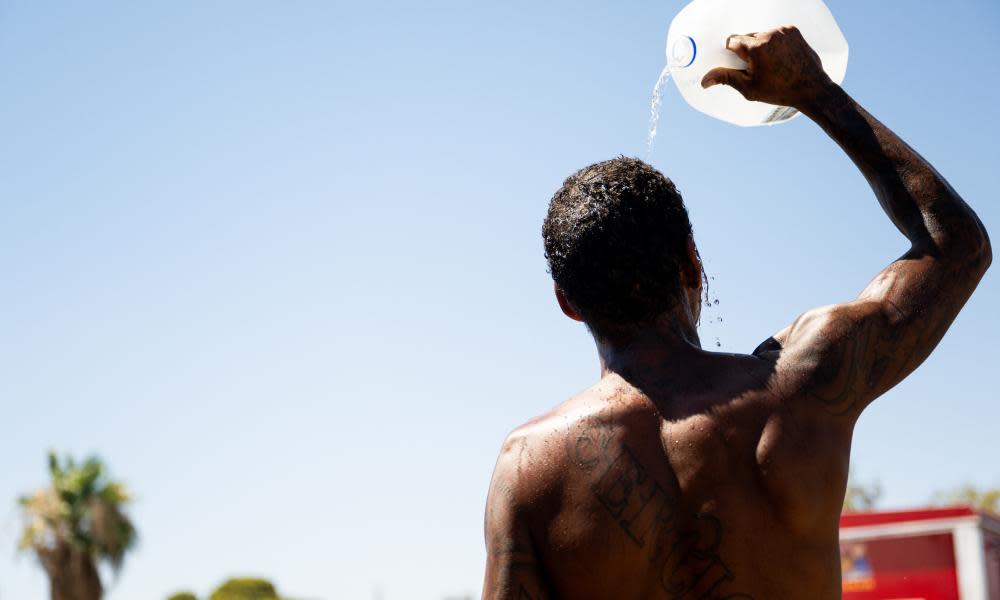Deadliest year on record as Phoenix heat fatalities rise by 50%

Heat deaths surged by 50% in Phoenix in 2023 – the deadliest year on record after extreme temperatures pummeled America’s hottest city, official figures show.
At least 579 people lost their lives to heat this year, with senior citizens accounting for one in three deaths, according to the year’s final heat surveillance report by the medical examiner’s office in Maricopa county, where Phoenix is located. Another 56 suspected heat deaths are still under investigation.
Related: A very American death: how Caleb Blair lost his life in the Phoenix heat
At least 45% of people who died were unsheltered and sleeping behind dumpsters, in car parks or on the burning hot sidewalk – even as daily temperatures hit 115F (46C) or higher on 22 different days. Heat deaths are always preventable given the right resources, according to public health experts.
The annual heat death toll has risen threefold since 2019, as the city’s affordable housing and addiction crises have converged with the climate emergency. Almost 1,900 people have died in the past five years, and thousands more have needed emergency medical help.
Phoenix, the capital of Arizona and America’s fifth-largest city with 1.6 million people, is accustomed to a hot desert climate, but temperatures are rising due to global heating – made worse by decades of unchecked urban development that created a sprawling heat island.
In 2021, the city created a dedicated extreme heat office to tackle the rising death toll and make the stifling urban landscape more livable by increasing tree cover and built shade – especially in low-income neighborhoods which are often the least green and the hottest.
In early August, the Democratic governor, Katie Hobbs, declared a statewide heat emergency after an unprecedented hot spell with 31 consecutive days at 100F or higher in Phoenix. The previous record was 18 consecutive days, recorded in 1974, according to the National Weather Service (NWS) in Phoenix.
The goal of the emergency declaration is to develop a coordinated response to tackle heat inequities across the state, but experts say that this will take time.
“Seniors, who are more vulnerable to extreme heat, are being displaced through increased housing costs at a rate faster than government agencies can find shelter for them. We are moving to more sustainable funding for emergency needs like cooling centers,” said Melissa Guardaro, assistant research professor at Arizona State University’s Global Institute of Sustainability and Innovation.
“One heat office is not going to make a dent in a housing and substance abuse crisis over the course of a year. We are seeing the impact of an intersectional crisis where extreme heat is exposing fractures in our infrastructure,” Guardaro said.
This summer was the hottest on record – in Phoenix and globally – and the prolonged searing heat would have been “virtually impossible” without human-made global heating, climate scientists found.
In Phoenix, the climate signal was strongest at night, when the temperature failed to drop below 90F (32C) on 35 days – another record. The hotter nights are particularly alarming for public health experts because heat is cumulative, and the body cannot start to properly recover until the temperature drops below 80F.
Related: Unhoused in Phoenix’s perilous heat: ‘If I don’t keep cool, I’ll die’
There is no accurate nationwide heat death toll, and Maricopa county produces the country’s most detailed heat mortality and morbidity information – thanks in large part to the heat-focused autopsies and field investigations carried out by the medical examiner’s officer.
According to the final weekly report, 30% of the heat victims in 2023 were women, compared with 19% last year. People of color accounted for 42% of heat deaths, with Black and Indigenous Americans the most disproportionately affected, census data suggests.
One in four people died indoors, and while 90% had air conditioning, in most cases the units did not function. At least two people who died inside had no electricity – a virtual death sentence in such extreme heat.
The city’s heat office did not respond to request for comment on this year’s high death toll, but in August the director, David Hondula, said: “We can get to zero deaths with the right resources … obviously no city anywhere in the world has yet demonstrated what the right mix of resources looks like for zero heat-related deaths, but [we’re] at the forefront of pursuing them.”
